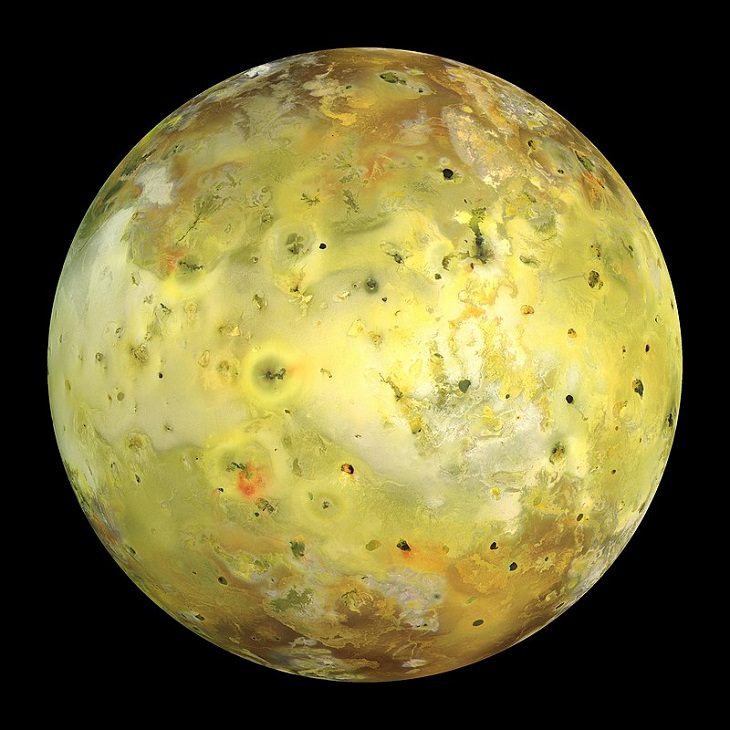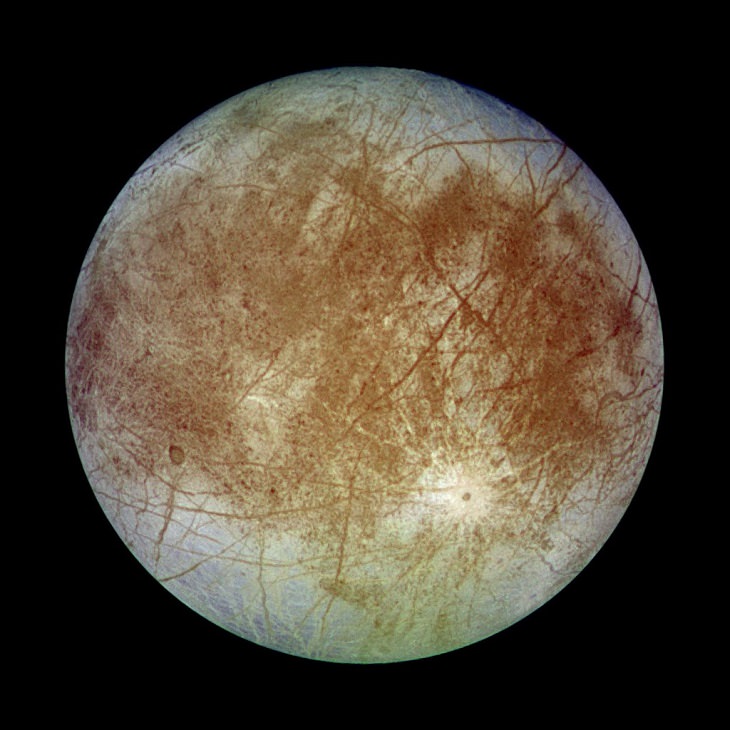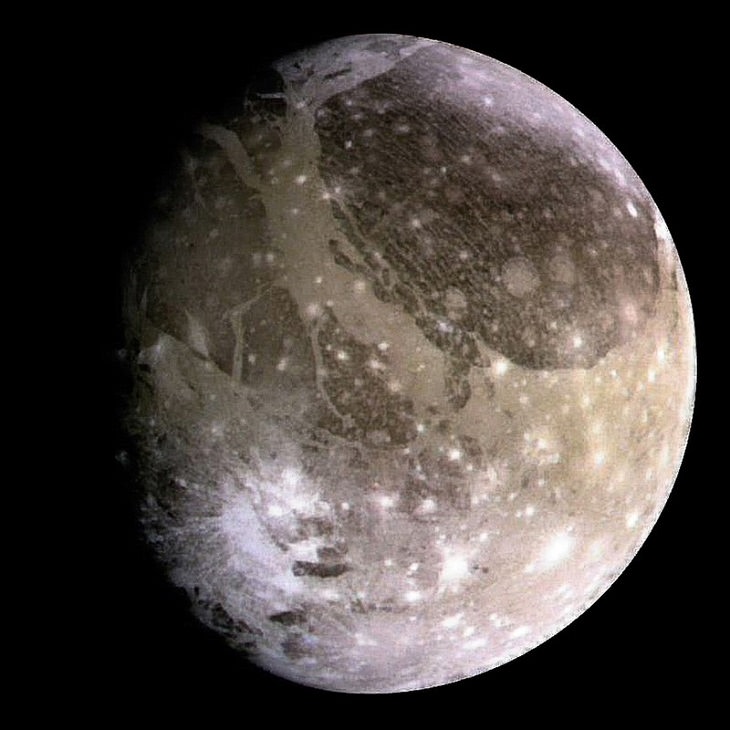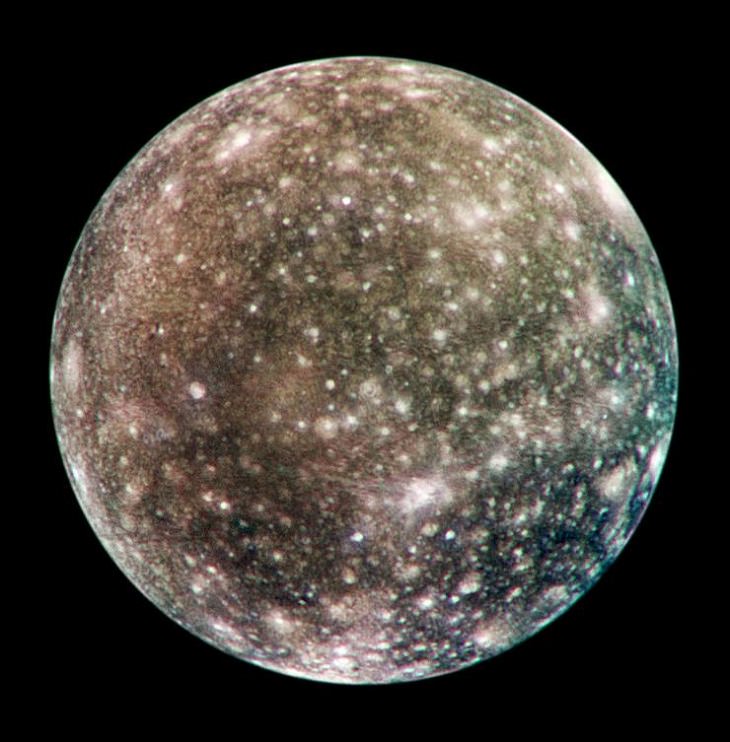
Jupiter, the gas giant, is the largest planet in the Solar System and the fifth planet from the Sun. Named after the Roman God Jupiter (also known as Jove; Zeus in Greek Mythology), this massive spatial body is the third brightest object in the night sky after the Moon and Venus. The light reflected off of its bright surface casts shadows that can be viewed from Earth, which is why this planet has been known to many ancient civilizations.
While our world has only one Moon orbiting it, Jupiter has a 79 identified moons, and many are still unidentified. Out of these 79, eight moons are what are referred to as regular moons - natural satellites falling into orbit in the opposite direction of Jupiter’s rotation. The 4 moons of the greatest prominence, those that possess some incredible features that may even show signs of extraterrestrial life, were discovered by the astronomer Galileo. Each of these 4 Galilean moons have their own unique appearances and features that may surprise you!

(By NASA / JPL / University of Arizona, Wikimedia Commons)
This is a true-color image of Jupiter’s moon Io taken by the Galileo Orbiter, an American unmanned spacecraft sent into orbit in 1989. This moon is the closest to the planet and the 3rd largest out of the 4 moons discovered by Galileo Galilei in 1610. These four moons are together referred to as the Galilean moons.
This moon was named Io, after a priestess of the Goddess Hera in Greek Mythology who betrayed her Goddess and became one of Zeus’ mistresses. This moon is also sometimes referred to as Jupiter I.
Io is the 4th largest moon in the entire solar system and also the densest. It is largely water-deficient, holding the least amount of water than any other astronomical body in our solar system. It is, however, the most geologically active planetary body, as it is home to 400 active volcanoes!
The volcanic activity is caused by the position of the planet between Jupiter and the other 3 Galilean moons, as the inner core of the moon is pulled between Jupiter and the other moons generating friction that causes rapid tidal heating.

(By NASA/JPL/DLR, Wikimedia Commons)
This image, taken by the Galileo spacecraft during its second orbit around Jupiter, shows the natural color of the ice-covered moon, Europa, also known as Jupiter II, the smallest of the Galilean moons. It is the 6th closest moon to Jupiter (out of all 79).
This moon was named after a Phoenician woman in Greek Mythology named Europa who was the mother of King Minos of Crete, and another mistress of Zeus (after whose Roman counterpart the planet Jupiter is named).
It is the 6th largest moon in the Solar System. It is only slightly smaller than Earth’s Moon. Its core is largely made up of iron-nickel, while its crust has been formed from silicate rock and a thick layer of water and ice. Its atmosphere is thin and composed primarily of oxygen.
Europa is especially unique because it is the smoothest and most youthful surface compared to other objects in the solar system. It has been hypothesized that this smoothness is due to the presence of an entire ocean under the surface of the planet, which may be home to extraterrestrial life.

(By NASA/JPL, Wikimedia Commons)
Behold the light surfaces and grooved terrains of Ganymede, as seen from the Galileo orbiter. It is the 7th closest moon of the planet and the 3rd of the Galilean moons. The moon takes roughly seven days to complete an orbit around the planet.
The namesake of this moon was a character from Greek Mythology who was a divine hero from the kingdom of Troy (where the Trojan War and the events of the Iliad took place). He was described as the most beautiful of the mortals and is whisked away by a smitten Zeus who appears in the form of an eagle to serve as the God’s cupbearer on Mount Olympus.
Ganymede has the largest diameter and mass of any other moon in the solar system, and it is the 9th largest astronomical body. It has an iron-rich core and its surface, much like Europa, is a mixture of equal parts water-ice and silicate rock.
Below its surface is an internal ocean that is believed to contain more water than the sum total found in Earth’s oceans. Ganymede is the only moon known to have a magnetic field, though it is heavily buried under Jupiter’s much larger magnetic field. While Ganymede experiences tidal heating similar to that of Europa, the result has been the presence of impact craters on the moon’s surface.

(By NASA/JPL/DLR(German Aerospace Center), Wikimedia Commons)
Callisto is the 8th moon from Jupiter and the second largest of its moons after only Ganymede. This photograph taken by the Galileo orbiter revealed a sub-silicate core under this moon’s surface, as well as the possibility of a sub-surface ocean. Like Ganymede, it requires 7 days to complete its orbital cycle around Jupiter.
Callisto was a nymph in Greek Mythology and a follower of Artemis, Goddess of the Hunt. Zeus became attracted to her and appeared to her in the form of Artemis to seduce her. On becoming pregnant with his child Arcas, she was cast aside by the followers of Artemis and turned into a bear by Hera. Just before she could be killed by her own son, a hunter, she was cast into the stars and became the constellation Ursa Major.
This planetary body is the third-largest moon in the solar system, wide in diameter but low in mass. It is the fourth Galilean moon, but is not in orbital resonance with the other three and therefore does not experience tidal heating. Its remote orbit also makes it less affected by Jupiter’s magnetic field.
Covered in impact craters, the surface of this moon is the oldest and the most heavily cratered in the solar system. While its atmosphere is composed greatly of carbon dioxide, with only trace amounts of oxygen, its low radiation levels and the possible presence of a sub-surface ocean has led it to be considered a suitable human base for future exploration.
Related Articles: